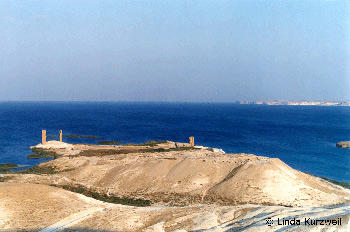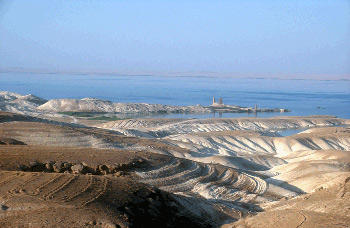Emar
Emar, or Imar, is the name of an ancient Near Eastern city in NW Syria. Emar was populated for more than a millennium, i.e. from about 3500 to 1150 BCE. Archaeologists refer to this time period as the Bronze Age. The remains of the city of Emar are located about 100 km East of the city of Aleppo close to the modern city of Meskene. After Emar’s abandonment around 1150 BCE it was not populated until the Byzantine Period, when it was called Barbalissos. With the advent of Islam it was renamed into Balis, and its final abandonment happened during the 13th century CE with the Mongolian conquest of the Near East.

Emar is located in the strategically important Upper Euphrates area, which connects Mesopotamia with the Mediterranean and Asia Minor. These connections are already evident in the earliest attestations of Emar in the palace archives from Ebla (c. 2500 BCE) and in the archives from Mari (c. 1800 BCE), which indicate that Emar represented an important cross-point between the Babylonian-Assyrian culture on the one hand and Syro-Anatolian culture on the other.
The Archaeological Excavations
Archaeological excavations at Emar began with the building of the Tabqa dam project in the 1970s. Two teams of French archaeologists conducted salvage excavations from 1972-1976. Jean-Claude Margueron headed the excavations of the ancient Near Eastern settlement, while the team of André Raymond explored the Byzantine and Islamic city.
Margueron’s team succeeded in unearthing several temples and living quarters of the Late Bronze Age (13th and early 12th centuries) and discovered about 800 cuneiform tablets written in Akkadian. Because of these texts it was finally possible to identify the settlement with the important city of Emar.
The completion of the Tabqa dam made further archaeological exploration of Emar impossible and the settlement was left unprotected. After the end of archaeological excavations it continued to be looted and several hundreds of tablets were sold on the antiquities market. In the beginning of the 1990s the Syrian Antiquities Services continued archaeological excavations of Emar, which is now partly submerged under water, albeit on a smaller scale. The Syrian team was headed by the archaeologist Shawki Sha’ath. In 1996 the University of Tübingen began a collaborative Syrian-German project to continue excavations at Emar. A team headed by Uwe Finkbeiner was able to conduct five campaigns until 2002.
The Syrian-German cooperative effort uncovered not only Late Bronze Age remains but also settlement strata of the Early and Middle Bronze Age (c. 2500-1500 BCE). More information about these excavations can be found online at http://www.uni-tuebingen.de/emar.
|
|
|
The Emar Texts
The cuneiform texts found at Emar were published by Daniel Arnaud in the middle of the 1980s. Their publication caused a minor sensation not only among Assyriologists but also among Biblical scholars as they showed close parallels to the Old Testament. The various text genres and topics of the Emar texts were studied in numerous monographs and scholarly articles.
Thus far we know of about 1180 texts from Emar. They are part of to the most important textual corpora from ancient Near Eastern texts from Syria. Unlike the tablets from Ugarit, Mari, and Ebla, which were found in palaces and were thus part of the state administration, the Emar tablets were found in private houses and therefore come from a very different social context. Most of the texts from Emar are legal documents, such as real estate sales, marriage contracts, or inheritance and adoption documents. These texts offer a fascinating insight into daily life of this ancient Near Eastern town. Excavations at the house of a priest uncovered literary works (wisdom texts and fragments of the Epic of Gilgamesh), religious texts (omen collections, incantations), lexical lists that are part of the Mesopotamian tradition, as well as ritual texts that were part of local religious customs. A ritual text describing the installation of the high-priestess of the weather god Ba’al is a particularly important find.
The Project Berlin-Zaragoza
In 2002 the project Berlin-Zaragoza was founded to facilitate access to and research on Emar texts. The project is a collaboration of the Institute of Ancient Near Eastern Languages and Civilizations (“Institut für Altorientalistik”) of the Freie Universität Berlin and the Instituto de Estudios Islámicos y del Oriente Próximo in Zaragoza, Spain. The project resulted in a complete bibliography on Emar, which is available in printed form and also online. The bibliography is updated regularly.
Building on the Berlin-Zaragoza cooperation, the online project “Materials for Emar Studies” was founded in 2006. This new project will make available further studies on Emar by various scholars:
Bibliographie der Emar-Studien (B. Faist, J.-P. Vita, J.-J. Justel)
Mehrmalige Textpublikationen (J.-P. Vita)
Index zur Grammatik der akkadischen Texte aus Emar von S. Seminara
(J.-J- Justel, B. E. Solans)
Orts- und Gewässernamen der Texte aus Emar (J. A. Belmonte)
Metrologie der Texte aus Emar (G. Chambon)
Publications in Preparation:
Personennamen der Texte aus Emar (R. Pruzsinszky)
Glossar der akkadischen Texte aus Emar (B. Faist, J.-P. Vita)
Since 2007 the Spanish ministry of culture has graciously supported the “Glossary of Akkadian Texts from Emar” as part of J.-P. Vita’s project “North-West Semitic Data Bank: Development and Use of New Technologies for the Study and Preservation of North-West Semitic Documents from the 2nd and 1st millennium BCE.”
Contact:
Dr. Betina Faist
Institut für Altorientalistik
Freie Universität Berlin
Hüttenweg 7
14195 Berlin
Germany
E-Mail: bfaist@zedat.fu-berlin.de
Dr. Juan-Pablo Vita
Instituto de Estudios Islámicos y del Oriente Próximo
c/de los Diputados 19-21
50004 Zaragoza
Spain
E-Mail: jpvita@ieiop.csic.es
Links
Excavation Emar
www.uni-tuebingen.de/emar
Materials for Emar Studies
www.ieiop.com/emar

